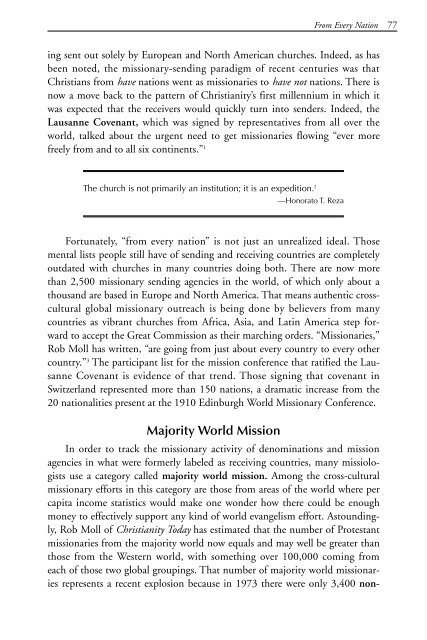discovering missions - Southern Nazarene University
discovering missions - Southern Nazarene University
discovering missions - Southern Nazarene University
Create successful ePaper yourself
Turn your PDF publications into a flip-book with our unique Google optimized e-Paper software.
245187 Disc Missions ins 9/6/07 1:04 PM Page 77<br />
ing sent out solely by European and North American churches. Indeed, as has<br />
been noted, the missionary-sending paradigm of recent centuries was that<br />
Christians from have nations went as missionaries to have not nations. There is<br />
now a move back to the pattern of Christianity’s first millennium in which it<br />
was expected that the receivers would quickly turn into senders. Indeed, the<br />
Lausanne Covenant, which was signed by representatives from all over the<br />
world, talked about the urgent need to get missionaries flowing “ever more<br />
freely from and to all six continents.” 1<br />
The church is not primarily an institution; it is an expedition. 2<br />
—Honorato T. Reza<br />
Fortunately, “from every nation” is not just an unrealized ideal. Those<br />
mental lists people still have of sending and receiving countries are completely<br />
outdated with churches in many countries doing both. There are now more<br />
than 2,500 missionary sending agencies in the world, of which only about a<br />
thousand are based in Europe and North America. That means authentic crosscultural<br />
global missionary outreach is being done by believers from many<br />
countries as vibrant churches from Africa, Asia, and Latin America step forward<br />
to accept the Great Commission as their marching orders. “Missionaries,”<br />
Rob Moll has written, “are going from just about every country to every other<br />
country.” 3 The participant list for the mission conference that ratified the Lausanne<br />
Covenant is evidence of that trend. Those signing that covenant in<br />
Switzerland represented more than 150 nations, a dramatic increase from the<br />
20 nationalities present at the 1910 Edinburgh World Missionary Conference.<br />
Majority World Mission<br />
From Every Nation 77<br />
In order to track the missionary activity of denominations and mission<br />
agencies in what were formerly labeled as receiving countries, many missiologists<br />
use a category called majority world mission. Among the cross-cultural<br />
missionary efforts in this category are those from areas of the world where per<br />
capita income statistics would make one wonder how there could be enough<br />
money to effectively support any kind of world evangelism effort. Astoundingly,<br />
Rob Moll of Christianity Today has estimated that the number of Protestant<br />
missionaries from the majority world now equals and may well be greater than<br />
those from the Western world, with something over 100,000 coming from<br />
each of those two global groupings. That number of majority world missionaries<br />
represents a recent explosion because in 1973 there were only 3,400 non-

















